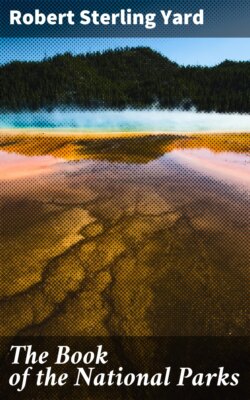Читать книгу The Book of the National Parks - Robert Sterling Yard - Страница 24
На сайте Литреса книга снята с продажи.
IV
ОглавлениеThe trail traveller finds the trails the best in the country, and as good as the best in the world; they are the models for the national system. Competent guides, horses, supplies, and equipment are easy to hire at regulated prices in the village.
As for the field, there is none nobler or more varied in the world. There are dozens of divides, scores of towering, snow-splashed peaks, hundreds of noble valleys and shining lakes, thousands of cascading streams, great and small, from whose depths fighting trout rise to the cast fly. There are passes to be crossed which carry one through concentric cirques of toothed granite to ridges from which the High Sierra spreads before the eye a frothing sea of snowy peaks.
Such a trip is that through Tuolumne Meadows up Lyell Canyon to its headwaters, over the Sierra at Donohue Pass, and up into the birth chambers of rivers among the summit glaciers of Lyell and McClure—a never-to-be-forgotten journey, which may be continued, if one has time and equipment, down the John Muir Trail to Mount Whitney and the Sequoia National Park. Or one may return to the park by way of Banner Peak and Thousand Island Lake, a wonder spot, and thence north over Parker and Mono Passes; trips like these produce views as magnificent as the land possesses.
Space does not permit even the suggestion of the possibilities to the trail traveller of this wonderland above the rim. It is the summer playground for a nation.
Second in magnificence among the park valleys is Hetch Hetchy, the Yosemite of the north. Both are broad, flowered and forested levels between lofty granite walls. Both are accented by gigantic rock personalities. Kolana Rock, which guards Hetch Hetchy at its western gateway as El Capitan guards Yosemite, must be ranked in the same class. Were there no Yosemite Valley, Hetch Hetchy, though it lacks the distinction which gives Yosemite Valley its world-wide fame, would be much better known than it now is—a statement also true about other features of the national park.
Hetch Hetchy is now being dammed below Kolana Rock to supply water for San Francisco. The dam will be hidden from common observation, and the timber lands to be flooded will be cut so as to avoid the unsightliness usual with artificial reservoirs in forested areas. The reservoir will cover one of the most beautiful bottoms in America. It will destroy forests of luxuriance. It will replace these with a long sinuous lake, from which sheer Yosemite-like granite walls will rise abruptly two or three thousand feet. There will be places where the edges are forested. Down into this lake from the high rim will cascade many roaring streams.
The long fight in California, in the press of the whole country, and finally in Congress, between the advocates of the Hetch Hetchy reservoir and the defenders of the scenic wilderness is one of the stirring episodes in the history of our national parks. At this writing, time enough has not yet passed to heal the wounds of battle, but at least we may look calmly at what remains. One consideration, at least, affords a little comfort. Hetch Hetchy was once, in late prehistoric times, a natural lake of great nobility. The remains of Nature's dam, not far from the site of man's, are plain to the geologist's eye. It is possible that, with care in building the dam and clearing out the trees to be submerged, this restoration of one of Nature's noble features of the past may not work out so inappropriately as once we feared.
From a photograph by J.T. Boysen
THE CLIMAX OF YOSEMITE NATIONAL PARK
Mount Lyell and its glacier from Lyell Fork
THE GREATEST WATERWHEEL OF THE TUOLUMNE It is fifty feet in height and seventy-five feet long; Yosemite National Park
The Grand Canyon of the Tuolumne, through which the river descends from the level of the Tuolumne Meadows almost five thousand feet to the Hetch Hetchy Valley, possesses real Yosemite grandeur. Much of this enormous drop occurs within a couple of amazing miles west of the California Falls. Here the river slips down sharply tilted granite slopes at breathless speed, breaking into cascades and plunging over waterfalls at frequent intervals. It is a stupendous spectacle which few but the hardiest mountaineers saw previous to 1918, so steep and difficult was the going. During that season a trail was opened which makes accessible to all one of the most extraordinary examples of plunging water in the world.
The climax of this spectacle is the Waterwheels. Granite obstructions in the bed of the steeply tilted river throw solid arcs of frothing water fifty feet in air. They occur near together, singly and in groups.
